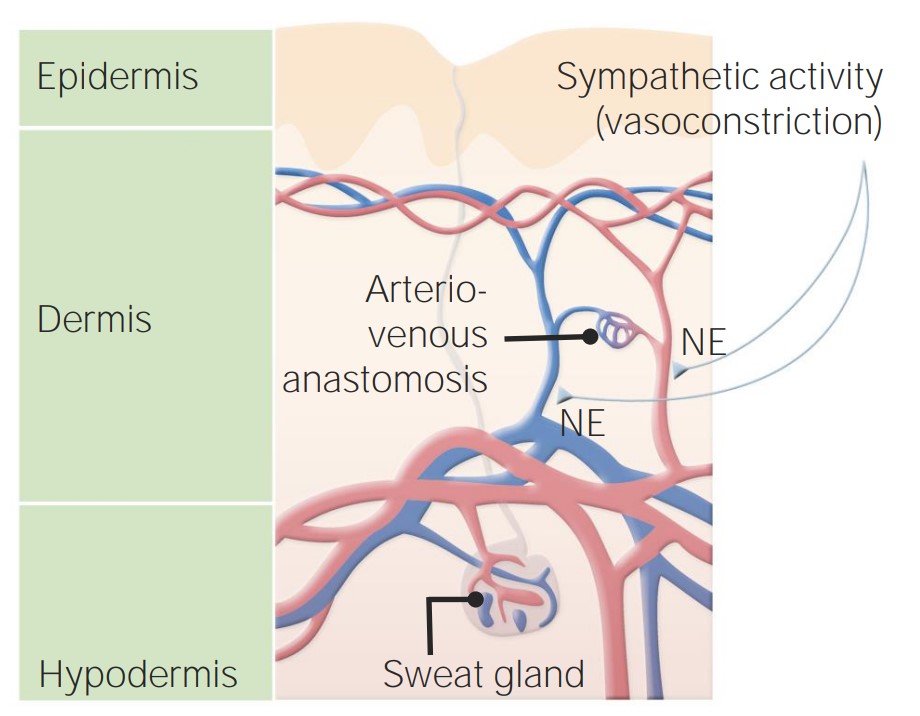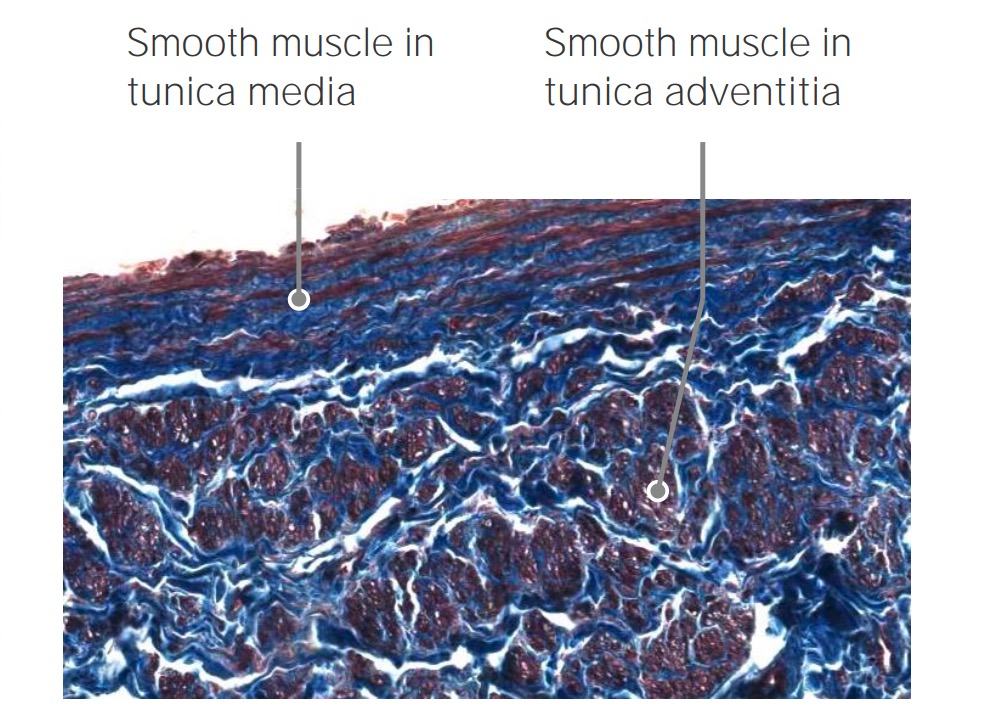Playlist
Show Playlist
Hide Playlist
Portal and Dual Circulations
-
Slides Structure-Function Relationships Cardiovascular System.pdf
-
Download Lecture Overview
00:01 Another concept, the portal circulation. 00:05 Really important concept. So what is a portal circulation? Technically, it is circulation that becomes a capillary bed that then coalesces and then expands out again into a second capillary bed in series. 00:21 That's what a portal circulation is. 00:23 The example that's on the screen right now is that associated with the hypothalamus and the anterior pituitary. 00:29 So the hypothalamus secretes hormones into the capillaries. 00:34 Okay, that's a good delivery system. 00:36 But we really only want them to bathe the cells of the anterior pituitary. 00:42 So those capillaries coalesce into a portal circulation, a portal vein, that then branches into a second capillary bed in the anterior pituitary. 00:52 So all the hormones that the hypothalamus is making, are being dumped into a second capillary bed around the anterior pituitary that then responds to the various hormones by making them the secondary hormones. 01:04 Make sense? Good. 01:06 Point is we have similar portal circulations in other places in the body, including that, for example, involving the adrenal cortex that drains through portal circulation into the medulla. 01:17 So the adrenal cortex influences what the medulla is doing in the adrenals. 01:22 Another example, a very important example is the hepatic portal circulation. 01:28 So we're looking at the small intestine, we're looking at the ascending colon, we're looking at the descending colon, the rectum and the sigmoid, but you get the sense that there is various venous structures that are removing or allowing to be circulated nutrients that have been taken up by various portions of the bowel. 01:49 Those are going in through the superior and inferior mesenteric veins. 01:53 So we, the bowel has done its thing. 01:55 It's absorbed nutrition. 01:57 And we want to bring that nutrition to a source where it can be metabolized very efficiently. 02:03 So the capillaries that were lining those structures that allow us to absorb those nutrients coalesce into the hepatic portal vein. 02:15 Okay, so we have all that capillaries. 02:17 Now, into a portal vein. 02:19 What's being shown here are the hepatic veins that will eventually drain out through the central hepatic vein into the inferior vena cava and back up to the heart. 02:31 Between the hepatic veins and the hepatic portal vein is a capillary bed. 02:36 It's the second capillary bed in this hepatic portal circulation. 02:41 So we are absorbing things from the small bowel and large bowel going in through the capillary bed, That is then coalescing into the hepatic portal vein that enters the liver. 02:55 And along with the hepatic artery delivers blood and nutrients to capillaries, the second capillary bed in series. 03:02 They are lined by the sinusoids then coalesce into the hepatic veins and out of the liver we go. 03:09 But the liver gets the first shot at all of the material that's been absorbed by the GI tract. 03:16 It can then metabolize the absorbed nutrients or can metabolize things that we don't want to have in the body. 03:23 Can detoxify, can remove evil humors. 03:29 Okay, another example of a portal circulation. 03:32 We are looking at on the left hand side, a renal arterial. 03:37 That renal arterial is going to enter into the glomerulus, exit from the glomerulus, as another small artery, and then we're going to go down into around the tubules. 03:50 Okay, let's look at this in turn. 03:51 So that renal artery branches into an afferent arteriole. 03:56 That is entrained into Bowman's space, and it's going to become the capillary bed within the glomerulus. 04:04 And this is where the first step of filtration is going to occur. 04:08 That capillary bed then coalesces back into a second arteriole. 04:13 So this is a little bit different than what we're talking about previously say with a portal vein, where we had capillary, portal vein, capillary. 04:21 Here we have artery, capillary, artery. 04:25 So, different organizations still a portal circulation. 04:28 Blood comes out of the glomerulus into the efferent arteriole and turns into a second capillary bed that is going to be important for then, providing perfusion and reuptake of necessary metabolites and ions from the tubule. 04:49 So we have a second capillary bed after the glomerulus, then we have the second portal capillary bed. 04:58 One last concept. So we've had collateral circulation. 05:02 We've had portal circulation. 05:06 Now, we're gonna talk about dual circulations. 05:08 And some structures in the body have two ways of being perfused. 05:14 The liver is a good example. 05:16 So the portal vein, as we've already talked about, brings about 75% of its blood volume from the portal vein, which is nutrient rich, but is oxygen depleted. 05:25 Now, liver is going to do a lot of metabolizing. 05:28 So it needs a good arterial blood supply as well, that comes in from the hepatic artery. 05:35 So about 25% of the perfusion to the liver derives from the hepatic artery, which is well oxygenated may not be as nutrient rich. 05:42 That combines with the portal vein, within the portal triad, and then turns into a capillary bed lined by sinusoids that will perfuse the entire liver. 05:55 So the liver has two means of circulatory support. 05:59 An artery, hepatic artery, and a portal vein. 06:03 As a result, it's reasonably difficult to infarct, the liver. 06:09 It can be done, if you have very low pressures and the heart is not functioning well, yes, you can have a hepatic infarct, but usually it's quite difficult. 06:20 Another dual circulation is in the lungs. 06:24 So we have most of the lung vasculature. 06:28 Most of the perfusion 99% deriving from the low-pressure pulmonary arteries. 06:35 We shouldn't worry too much about oxygenation in the lung, because remember, the lungs are breathing. 06:40 So they have the most robust amount of oxygen. 06:44 But we do need to provide nutrition. 06:47 99% of the blood supply comes from the pulmonary arteries. 06:52 Okay.1% of the pulmonary perfusion derives from high pressure bronchial arteries indicated here with the arrow. 07:02 And that is intended primarily to provide blood supply to the bronchi and bronchioles. 07:09 However, there is a collateralization that happens between the pulmonary artery and the bronchial artery. 07:16 So as a result, it's actually quite difficult to infarct the lung as well. 07:20 Again, it can be done if you try hard enough.
About the Lecture
The lecture Portal and Dual Circulations by Richard Mitchell, MD, PhD is from the course Structure-Function Relationships in the Cardiovascular System.
Included Quiz Questions
A portal circulation can be described as which of the following?
- Arteriole - capillary bed - vein - capillary bed - venule
- Artery - arteriole - capillary bed - venule - vein
- Vein - venule - artery - capillary bed - arteriole
- Aorta - vein - capillary bed - inferior vena cava - capillary bed - venule
- Arteriole - venule - vein - arteriole - heart
The nutrients of the GI tract are directed toward the liver by which structure?
- The portal vein
- The hepatic artery
- The hepatic vein
- The inferior vena cava
- The inferior mesenteric artery
How does the renal portal circulation differ from most other portal circulations?
- It is composed of two arterioles connected to a capillary bed.
- It consists of three capillary beds joined by a vein in between each bed.
- It consists of all renal capillary beds set up in parallel circuits.
- It consists of two capillary beds joined by a vein instead of an artery.
- It is composed of the afferent vein, glomerulus, efferent vein, and tubular capillary.
What is an advantage of having a dual circulation?
- It makes the tissue more difficult to infarct.
- It makes the tissue less likely to become infected.
- It allows the tissue to extract more oxygen.
- It allows the organs to be used for transplantation.
- It allows for faster cellular metabolism.
Which vessels bring blood to the lungs from the heart?
- The pulmonary arteries and the bronchial arteries
- The pulmonary veins and the bronchial veins
- The pulmonary arteries and the bronchial veins
- The pulmonary veins and the bronchial arteries
- The azygos vein and the bronchial veins
Customer reviews
5,0 of 5 stars
| 5 Stars |
|
5 |
| 4 Stars |
|
0 |
| 3 Stars |
|
0 |
| 2 Stars |
|
0 |
| 1 Star |
|
0 |





